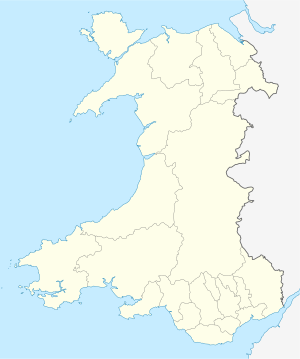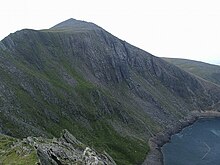Dinorwig pumped storage power plant
| Dinorwig pumped storage power plant | ||
|---|---|---|
| The power plant at Elidir Fawr | ||
| location | ||
|
|
||
| Coordinates | 53 ° 7 '7 " N , 4 ° 6' 50" W | |
| country |
|
|
| place | Llanberis | |
| Waters | Marchlyn Mawr Reservoir, Llyn Peris | |
| power plant | ||
| construction time | 1974-1984 | |
| technology | ||
| Bottleneck performance | 1,728 megawatts | |
| Turbines | 6 × Francis turbines | |
| Generators | 6 × GEC generators à 288 MW | |
| Others | ||
The Dinorwig pumped storage power station ( English Dinorwig power station , also English Dinorwic ) is located near Dinorwig near the village of Llanberis in the Snowdonia National Park in Gwynedd , North Wales , Great Britain. With an output of 1728 MW, it is the most powerful pumped storage plant in Europe and the third most powerful in the world. It is needed to cover peak loads in the public power supply network .
The water is stored at high altitudes in the Marchlyn Mawr Reservoir and is discharged into the Llyn Peris by turbines during periods of high energy demand. It is pumped back from the Llyn Peris to the Marchlyn Mawr during times of low power consumption.
The plant was built from 1974 to 1984 in the abandoned Dinorwic quarry . In order to disturb the national park less, the power plants were built deep in the mountain Elidir Fawr. The total cost of construction was £ 425 million. (Adjusted for inflation, this equates to £ 1,376 million today.) It was the UK government's largest construction project to date. The contractor was a consortium made up of Alfred McAlpine , Brand and Zschokke . 1 million tons of concrete, 200,000 tons of cement and 4,500 tons of steel were used in the construction. 12 million tons of rock had to be broken out. 16 km of tunnels were created, some of them wide enough for two trucks to comfortably meet, and a cavern with the dimensions: 51 m high, 180 m long and 23 m wide, which is known as the “concert hall”. The power station at Pentir is connected to the British national grid by a 400 kV cable that is buried over a distance of 10 km so that no electricity pylons can be seen.
The power plant has six 288 MW GEC generators coupled with Francis turbines , which can also run backwards as pumps. The generators have a vertical axis. From a standstill, a 450-ton generator can be synchronized in 75 seconds and run to full load. With synchronized generators, the output of 1728 MW can be achieved within 16 seconds from idle. The power plant can run for six hours with one tank filling.
Excess water drains to the Llyn Padarn. Both Llyn Peris and Llyn Padarn, home of were lake trout (Arctic char), a rare fish in the UK. When the facility started operating, the fish were caught and taken to other lakes. Therefore, it is believed that this species of fish no longer exists here because of the fluctuating water levels.
The pumped storage power plant was originally built to compensate for the constant but inflexible base load of the British nuclear power plants during peak load times. But it can only store the electricity from a nuclear power plant for a few hours. There are now more flexible gas-fired power plants, so the need for pumped storage power plants to compensate for electricity demand has decreased between day and night. That is why another PSP was never built in Exmoor . Dinorwig now serves more to compensate for rapid peaks in demand, for example at the end of popular TV programs, when many people switch on the lights and electrical devices at the same time. It is therefore very important to watch TV programs to control electricity generation.
Another important purpose of Dinorwig is that it can help restart the power grid in the event of a complete failure. It also has some diesel generators and large batteries that enable a black start. However, some fossil fuel power plants can do that too.
The power plant has an average efficiency of 74–75%, which means that when pumping it uses 33% more electricity than it produces. This is still cheaper than having additional power plants available when idling.
The power plant is also a tourist attraction. Visitors can take a minibus into the so-called "Electric Mountain".
See also
swell
- ↑ VDI-Lexikon Energietechnik quoted from Achim Dittmann: Energy storage: Bad weather - no energy? (PDF file; 2.44 MiB) p. 61 , archived from the original on January 5, 2012 ; accessed on July 14, 2013 (Technische Universität Dresden, Environmental Ring Lecture 2008).
- ^ Dinorwig - The Electric Mountain , Elaine Williams, A National Grid Publication, 1991
- ^ The Road to Success: Alfred McAlpine 1935–1985, p. 14, Tony Gray, Rainbird Publishing, 1987
- ↑ International Power ( Memento of the original from May 12, 2016 in the Internet Archive ) Info: The archive link was inserted automatically and has not yet been checked. Please check the original and archive link according to the instructions and then remove this notice.
- ↑ First Hydro webpage ( Memento of the original from May 12, 2016 in the Internet Archive ) Info: The archive link was inserted automatically and has not yet been checked. Please check the original and archive link according to the instructions and then remove this notice.
- ↑ National Grid leaflet: "Forecasting Demand" (English) ( Memento of the original from December 29, 2009 in the Internet Archive ) Info: The archive link was inserted automatically and has not yet been checked. Please check the original and archive link according to the instructions and then remove this notice.



